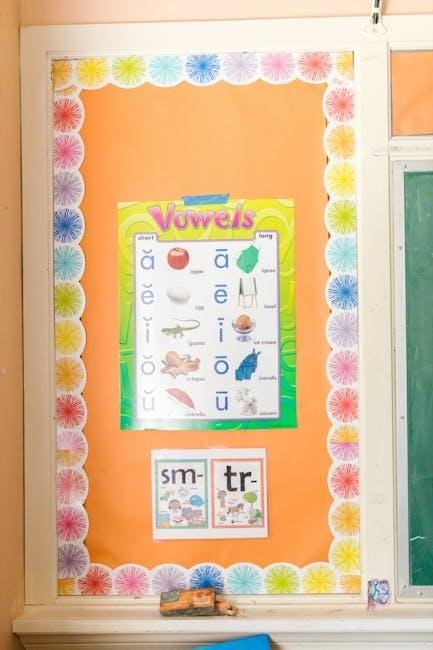phonics scope and sequence pdf
method to build phonics knowledge and proficiency in young learners effectively always.
Definition and Importance
A phonics scope and sequence pdf is a document that outlines the order and progression of phonics skills to be taught in a classroom setting, providing a clear and structured approach to reading instruction. The definition of phonics scope and sequence is closely tied to its importance, as it enables teachers to deliver a systematic and explicit phonics program. This, in turn, helps students develop a strong foundation in reading and decoding skills. The importance of a phonics scope and sequence pdf lies in its ability to ensure that students receive a comprehensive and cohesive phonics education, with each skill building on the previous one. By using a phonics scope and sequence pdf, teachers can ensure that their students are well-equipped to tackle more complex reading tasks and develop a lifelong love of reading. Effective phonics instruction is critical to student success, and a well-structured scope and sequence is essential to achieving this goal.
Free Phonics Scope and Sequence PDF
To support teachers in their phonics instruction, many organizations offer a free phonics scope and sequence pdf that can be downloaded and used in the classroom. These resources are often designed to be flexible and adaptable, allowing teachers to tailor their instruction to meet the needs of their students. The free phonics scope and sequence pdf typically includes a detailed outline of the phonics skills to be taught, along with suggestions for instructional activities and assessments. By providing a free phonics scope and sequence pdf, organizations aim to make high-quality phonics instruction more accessible and affordable for teachers and schools. This can be especially beneficial for schools with limited resources or for teachers who are new to phonics instruction. With a free phonics scope and sequence pdf, teachers can deliver effective and systematic phonics instruction, helping their students to develop strong reading and decoding skills. Using these resources can also help to reduce planning time and increase teacher confidence.

Phonics Scope and Sequence Structure

Phonics scope and sequence structure involves a
- logical
and systematic approach to teaching reading skills effectively always online.
Grade Level Estimations
Grade level estimations for phonics scope and sequence are crucial in determining the appropriate skills to be taught at each level. The estimations are typically indicated next to the phonics sounds, with rough grade levels such as K, grade 1, or grade 2. This helps teachers to plan their instruction and ensure that students are learning the necessary skills at the right time. A
- comprehensive
understanding of grade level estimations is essential for effective phonics instruction. By using a
- systematic
approach to teaching phonics, teachers can help students build a strong foundation in reading and spelling. Grade level estimations also allow teachers to identify areas where students may need extra support or review, and to adjust their instruction accordingly. With a clear understanding of grade level estimations, teachers can create a
coherent
and effective phonics program that meets the needs of all students. This helps to ensure that students are well-prepared for future academic success.
Key Components of Phonics Scope and Sequence
The key components of phonics scope and sequence include a logical and sequential approach to teaching phonics skills. This involves starting with simple skills and progressing to more complex ones, with each skill building on the previous one. A
- comprehensive
phonics scope and sequence should also include spelling patterns, syllables, and morphology. The use of
- assessment
is also crucial in determining where students should begin instruction and in monitoring their progress. By including these key components, a phonics scope and sequence can provide a clear and effective roadmap for teaching phonics skills. This helps to ensure that students receive a thorough and well-structured phonics education, which is essential for reading and spelling proficiency. With a well-designed phonics scope and sequence, teachers can help students develop a strong foundation in phonics and lay the groundwork for future academic success. Effective implementation of these components is critical to achieving this goal.

Phonics Scope and Sequence for Different Grades
Phonics instruction varies by grade level, with
- customized
approaches for each grade, ensuring effective learning always using proper methods and techniques.
Phonics Scope and Sequence for Grade 1
For Grade 1, the phonics scope and sequence typically includes a range of skills, such as short vowels, long vowels, and consonant blends, with a focus on building foundational reading skills.
The sequence is designed to be logical and sequential, with each skill building on the previous one, and is usually divided into units or weeks, with specific skills and concepts covered in each unit.
A typical phonics scope and sequence for Grade 1 might include units on short vowels, long vowels, consonant blends, and inflected endings, with a focus on applying these skills to decode and read words.
The goal is to provide a comprehensive and systematic approach to teaching phonics, with a focus on helping students develop the skills and confidence they need to become proficient readers.
Using a phonics scope and sequence can help teachers ensure that they are covering all the necessary skills and concepts, and can help students make steady progress in their reading development.
This approach can be customized to meet the needs of individual students and classrooms, and can be used in conjunction with other reading instruction methods.
By following a phonics scope and sequence, teachers can help their students develop a strong foundation in reading and set them up for success in later grades.
The sequence is designed to be flexible and adaptable, with opportunities for review and practice, and can be used to support students who may be struggling with phonics concepts.
Overall, a phonics scope and sequence for Grade 1 provides a comprehensive and systematic approach to teaching phonics, and can help students develop the skills and confidence they need to become proficient readers.
Unit Breakdown for Grade 1
A unit breakdown for Grade 1 phonics typically includes 5-6 units, each covering specific skills and concepts, such as short vowels, long vowels, and consonant blends.
The units are designed to be taught in a logical and sequential order, with each unit building on the previous one.
For example, Unit 1 might cover short vowels, with a focus on decoding and reading words with short vowel sounds.
Unit 2 might cover long vowels, with a focus on decoding and reading words with long vowel sounds, and so on.
Each unit is typically divided into weeks, with specific skills and concepts covered in each week, and includes opportunities for review and practice.
The unit breakdown provides a clear and detailed outline of the phonics skills and concepts to be covered, and helps teachers plan and deliver effective phonics instruction.
Using a unit breakdown can help teachers ensure that they are covering all the necessary skills and concepts, and can help students make steady progress in their reading development.
The breakdown is designed to be flexible and adaptable, with opportunities for review and practice, and can be used to support students who may be struggling with phonics concepts.

Best Practices for Phonics Instruction
Effective phonics instruction involves using a systematic and explicit approach, with a focus on building phonemic awareness and decoding skills, using a variety of teaching methods and materials always effectively online, daily.
Logical Ordering of Phonics Concepts
A logical ordering of phonics concepts is essential for effective instruction, as it allows students to build on prior knowledge and skills, progressing from simple to complex concepts in a sequential manner.
This approach enables teachers to introduce new skills and concepts in a way that is easy for students to understand and apply, using a variety of teaching methods and materials, and incorporating regular assessment and feedback to ensure students are progressing as expected.
The logical ordering of phonics concepts also helps to prevent confusion and frustration, as students are able to see the relationships between different skills and concepts, and understand how they fit together to form a cohesive whole.
By using a logical and sequential approach to phonics instruction, teachers can help students develop a strong foundation in reading and spelling, and set them up for success in all areas of literacy.
This approach is supported by research and is a key component of effective phonics instruction, and is used in many educational settings, including schools and tutoring programs, to help students achieve their full potential.
Assessment and Progression
Assessment and progression are crucial components of a phonics scope and sequence, as they enable teachers to monitor student progress and adjust instruction accordingly.
Using a variety of assessment tools and methods, teachers can identify areas where students may need additional support or review, and provide targeted instruction to help them catch up.
Regular assessment also helps teachers to determine when students are ready to progress to more complex phonics concepts, and to identify any gaps in their knowledge or skills.
By using assessment data to inform instruction, teachers can ensure that students are progressing at a pace that is appropriate for their needs, and that they are well-prepared for more advanced literacy skills.
This approach helps to ensure that students are able to build on their prior knowledge and skills, and make steady progress towards becoming proficient readers and writers, with a strong foundation in phonics and literacy skills.
Effective assessment and progression strategies are essential for helping students achieve their full potential in literacy.


